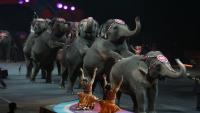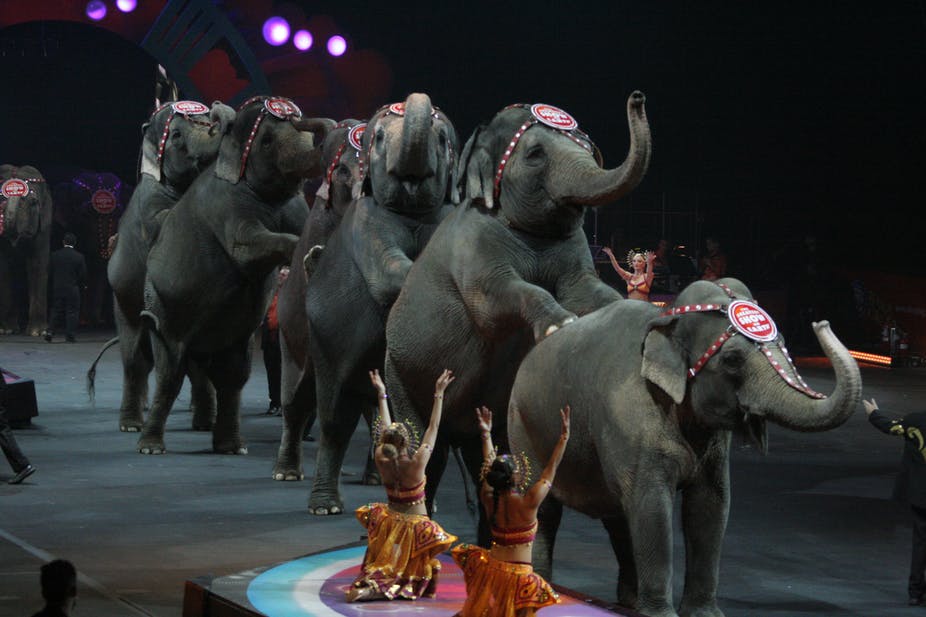The “Greatest Show On Earth,” the 146-year-old Ringling Bros. and Barnum & Bailey Circus, announced in January that it will finally close in May. The circus was simply not sufficiently spectacular to compete with the entertainment wonders offered by smartphones and tablets, or with rock concerts and monster truck shows.
Animal advocates, who have criticized circuses for years for exhibiting elephants, are calling this decision a victory, although the company had already announced in 2015 that it would stop using elephants in its shows in response to public criticism. Certainly, we can be glad if this action alleviates the misery of these individual elephants (although, as explained below, that is far from clear), or stops other animals from being used in future circuses.
But Ringling’s owners made a business decision that had nothing to do with what animal advocates said or did. Instead, executives made it clear the shows the circus produced were not viable as a business model. And closing the circus does nothing to change our institutions of animal use – most importantly, the fact that we eat animals. As scholars of animals rights and advocates for veganism as a moral imperative, we do not view it as a victory.
Why focus on elephants?
Tastes change, and consumer demand determines which businesses survive. Early circuses exhibited humans in appalling and exploitative ways, spotlighting “bearded ladies,” conjoined twins, and performers with dwarfism, gigantism, disabilities and illnesses.
As those practices phased out over the past century, circuses put more emphasis on clowns, acrobats, high-wire walkers and wild animal acts. The carnival atmosphere of the traveling circus gradually gave way to the more refined, artistic performances of companies like Cirque du Soleil.
Our view of animal acts also became more nuanced, varied and conflicted, particularly in the case of elephants. Large circuses once offered a rare opportunity to see these animals, but today we can see footage of elephants in their own habitats whenever we wish.
We also have come to understand much more clearly that elephants are intelligent and complex animals. They have joined dolphins, orcas and great apes in a small, privileged club of “special” animals that humans, particularly Westerners, fret about, feel conflicted about and perhaps are willing to accord more respect.
In 2015, Ringling announced that it would retire its performing elephants by 2018. Although the elephants will still be subjected to research and bred, and live in a very small “sanctuary,” animal welfare groups who had campaigned to end the circus company’s elephant acts celebrated. And when Ringling announced this month that it was going out of business, People for the Ethical Treatment of Animals told its supporters, “Thirty-six years of PETA protests, of documenting animals left to die, beaten animals, and much more, has reduced attendance to the point of no return.”
Justifying animal exploitation
Such claims completely miss the elephant in the room. Humans kill and eat 70 billion land animals and at least a trillion sea animals annually. All other uses of animals – from circuses to rodeos to medical research – pale in comparison.
Yet most animal welfare groups do not maintain that using animals for food raises the same moral imperative that they assign to using elephants in circuses, clubbing baby seals for their pelts or eating of dogs and cats by Asians. This reflects these organizations’ fundraising strategy, which presents acts of cruelty to animals as frivolous and unnecessary – for example, wearing fur coats. They promise to address those issues on their supporters’ behalf, without asking anyone to change their diet, lifestyle or outlook. Elephants were perfect for this strategy.
However, animal welfare groups have entered into unholy alliances with companies and whole industries that have animal exploitation at their core. They work with animal industries to reassure the public that there is a “compassionate” way to exploit animals, and even license or support certification labels for “humane” animal products.
For example, in 2005 Princeton University philosopher Peter Singer wrote a public letter on behalf of a number of animal welfare groups expressing “appreciation and support” for Whole Foods Market’s program to ensure supposedly more “humane” treatment of farm animals. This inaugurated what we call the “happy exploitation” movement.
But animals are chattel property, and animal welfare standards will, as a general matter outside of niche markets for the affluent, do little more than make animal use more economically efficient. Even animal welfare groups recognize that their “business” is helping industry to identify inefficient animal treatment in order to have a better bottom line. For example, both PETA and The Humane Society of the United States promote the controlled-atmosphere method of poultry slaughter based on economic efficiency.
Eating animals: Unnecessary and unjustified
For more than 200 years, we have embraced the idea that animals have moral value – they are not just things. This view is reflected in legislation to ensure the “humane” treatment of animals, which dates back to the 19th century. Most of us believe that it is wrong to inflict “unnecessary” suffering on animals. This must mean that we cannot justify imposing suffering on animals for our simple pleasure, amusement or convenience.
But we would argue that, on a daily basis, we impose unnecessary suffering on animals. The idea that people need to consume animal products for optimal health has been debunked by professional organizations, such as the Academy of Nutrition and Dietetics and the American Heart Association; health care providers, such as the Mayo Clinic; government agencies, such as the National Institutes of Health and the British National Health Service; and insurance giants, such as Kaiser Permanente.
All of these authorities agree that a sound plant-based diet can provide adequate nutrition. Some claim that it can be better for human health than a diet that includes animal products. We eat animals for one reason: We enjoy it. We find it convenient to pick up a burger or a bucket of fried chicken. We have no more moral justification for eating hamburgers than for exploiting elephants in circuses.
If we want to take the issue of animal ethics seriously, we need to move away from debating treatment of this or that animal in specific circumstances. Instead, we should focus on justifying animal use in light of our conventional wisdom that animals have moral value and that we need a reason to impose suffering and death on them. For 99.9 percent of our animal use, we simply don’t have one.
The outcry against consumption of dogs and cats in Asian countries is deafening, and often involves ethnocentrism and xenophobia. But there is absolutely no moral difference between eating dogs and eating chickens or cheese.
And as long as we eat animals, nothing will change. Once we appreciate that our use of animals for food is no different from the use of elephants in circuses, the clubbing of baby seals or dogfighting, our entire perspective will change and the social discussion will shift from (supposedly) “humane” treatment to our justifications for animal use.




